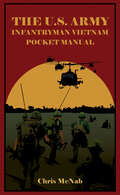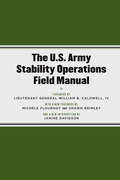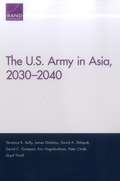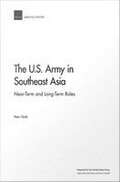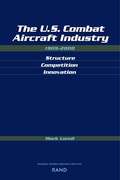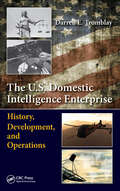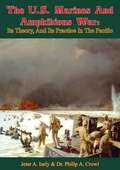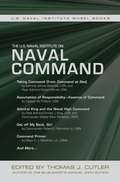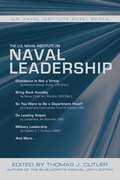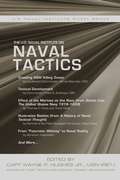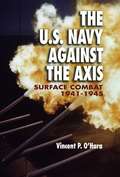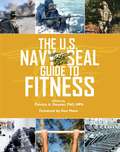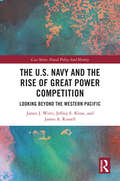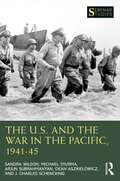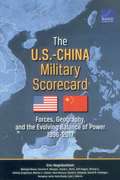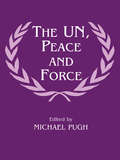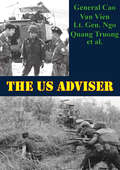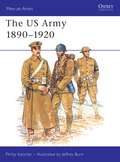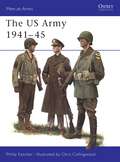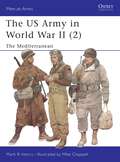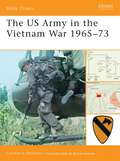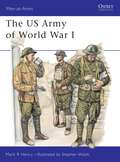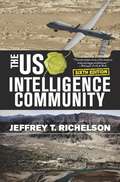- Table View
- List View
The U.S. Army Infantryman Vietnam Pocket Manual (The\pocket Manual Ser.)
by Chris McNabPocket manuals bring together a wealth of information from a wide variety of training manuals and tactical documents. Between 1964 and 1975, 2.6 million American personnel served within the borders of South Vietnam during the Vietnam War, of whom an estimated 1–1.6 million actually fought in combat. At the tip of the spear was the infantry, the "grunts" who entered an extraordinary tropical combat zone completely alien to the world they had left behind in the United States. In South Vietnam, and occasionally spilling over into neighboring Laos and Cambodia, they fought a relentless counterinsurgency and conventional war against the North Vietnamese Army (NVA) and Viet Cong (VC). The terrain was as challenging as the enemy – soaring mountains or jungle-choked valleys; bleached, sandy coastal zones; major urban centers; riverine districts. Their opponents fought them with relentless and terrible ingenuity with ambushes, booby traps, and mines, then occasionally with full-force offensives on a scale to rival the campaigns of World War II. This pocket manual draws its content not only from essential U.S. military field manuals of the Vietnam era, but also a vast collection of declassified primary documents, including rare after-action reports, intelligence analysis, firsthand accounts, and combat studies. Through these documents the pocket manual provides a deep insight into what it was like for infantry to live, survive, and fight in Vietnam, whether conducting a major airmobile search-and-destroy operation or conducting endless hot and humid small-unit patrols from jungle firebases. The book includes infantry intelligence documents about the NVA and VC threats, plus chapters explaining hard-won lessons about using weaponry, surviving and moving through the jungle, tactical maneuvers, and applications of the ubiquitous helicopter for combat and support.
The U.S. Army Stability Operations Field Manual: U.S. Army Field Manual No. 3-07
by Caldwell Iv William Flournoy Michele Brimley Shawn Davidson JanineField Manual 3-07,Stability Operations, represents a milestone in Army doctrine. With a focus on transforming conflict, managing violence when it does occur and maintaining stable peace,The U. S. Army Stability Operations Field Manual(otherwise known as FM 3-07) signals a stark departure from traditional military doctrine. The Army officially acknowledges the complex continuum from conflict to peace, outlines the military's responsibility to provide stability and security, and recognizes the necessity of collaboration, coordination, and cooperation among military, state, commercial, and non-government organizations in nation-building efforts. The manual reflects a truly unique collaboration between the Army and a wide array of experts from hundreds of groups across the United States Government, the intergovernmental and non-governmental communities, America's allies around the world, and the private sector. All branches of the armed forces, U. S. agencies ranging from the State Department to Homeland Security to Health and Human Services, international agencies from the United Nations to the Red Cross to the World Bank, countries from the United Kingdom to India to South Africa, private think tanks from RAND to the United States Institute of Peace to the Center for New American Security, all took part in the shaping of this document. The U. S. Army Stability Operations FieldManual,marks just the second time in modern history that the U. S. Army has worked with a private publisher to produce a military doctrinal document. Lieutenant General William B. Caldwell, IV is Commander of the Combined Arms Center at Fort Leavenworth, Kansas. Michèle Flournoy, Under Secretary of Defense for Policy Shawn Brimley, Fellow, Center for a New American Security Janine Davidson, Deputy Assistant Secretary of Defense for Plans "It is a roadmap from conflict to peace, a practical guidebook for adaptive, creative leadership at a critical time in our history. It institutionalizes the hard-won lessons of the past while charting a path for tomorrow. This manual postures our military forces for the challenges of an uncertain future, an era of persistent conflict where the unflagging bravery of our Soldiers will continue to carry the banner of freedom, hope, and opportunity to the people of the world. " -From the foreword by Lieutenant General William B. Caldwell, IV, Commander of the Combined Arms Center at Fort Leavenworth, Kansas
The U.S. Army in Asia, 2030-2040
by James Dobbins Peter Chalk David C. Gompert Terrence K. Kelly Eric Heginbotham David A. Shlapak Lloyd ThrallLooking to the 2030-2040 time frame, U. S. policy and military strategy will need to strike a balance among maintaining a cooperative relationship with China, deterring Chinese aggression in regional disputes, and preparing for the possibility that China could become more assertive. The U. S. Army will have an important role to play in preparing for these developments and for protecting and furthering U. S. interests in the region.
The U.S. Army in Southeast Asia: Near-Term and Long-Term Roles
by Peter ChalkThis RAND report examines the U.S. Army role in Southeast Asia. Under current benign conditions, efforts should focus on supporting defense reform, addressing transnational threats, and balancing China. If the outlook deteriorates, the United States should increase security cooperation, conclude new regional basing agreements, expand disaster assistance, and create policies to encourage risk-averse Chinese behavior.
The U.S. Combat Aircraft Industry, 1909-2000
by Mark A. LorellDrawing on primary and secondary sources on the aircraft industry, this report provides a brief survey of industry structure, innovation, and competition in the U.S. fixed-wing combat aircraft industry from its earliest days to the present. It supports a much larger research effort examining the future of the structure, innovation, and competition of the U.S. military aircraft industrial base that responds to congressional concerns about that future.
The U.S. Domestic Intelligence Enterprise: History, Development, and Operations
by Darren E. TromblayMuch has been written about U.S. intelligence operations. However, intelligence, as it is conducted in the U.S. domestic environment, has usually been treated in a fractured and sensationalistic manner. This book dispassionately assesses the U.S. domestically oriented intelligence enterprise by first examining its individual components and then sho
The U.S. Marines And Amphibious War: Its Theory, And Its Practice In The Pacific
by Jeter A. Isely Dr Philip A. Crowl"Not only a just appraisal of the campaigns waged by Marines in World War II; it is a documentation of the Marine struggle to prove the feasibility of amphibious warfare....Relentlessly accurate and impartial."--N.Y. TimesOriginally published in 1951, this book is a widely regarded classic on US Marine amphibious doctrine and operations employed in the Pacific during the Second World War. The authors describe in detail the development of the theoretical aspects of amphibious assault in the inter-war period, but devote the vast majority of the narrative to the various landings and their core strategies, using Japanese documents "to sketch in the background of military decisions made by the enemy." A must for those who wish to understand the American war against Japan.
The U.S. Naval Institute on Naval Command
by Edited by Thomas J. Cutler"Wheel books” were once found in the uniform pockets of virtually all junior officers and many senior petty officers. Each small notebook was unique to the Sailor carrying it, but all had in common a collection of data and wisdom that the individual deemed useful in the effective execution of his or her duties. Often used as a substitute for experience among neophytes and as a portable library of reference information for more experienced personnel, those weathered pages contained everything from the time of the next tide, to leadership hints from a respected chief petty officer, to the color coding of the phone-and-distance line used in underway replenishments. In that same tradition, the Naval Institute has created and aptly named the Wheel Book series, portable libraries culled from USNI’s vast array of information that has accumulated for more than a century. Articles from the Institute’s flagship publication Proceedings are combined with selections from USNI’s oral history program and from Naval Institute Press books to create unique guides on a wide array of relevant professional subjects. Just as the "wheel books” of yesterday served the fleet well, the Naval Institute Wheel Books of today provide supplemental information, pragmatic advice, and cogent analysis on topics important to modern naval professionals. The pinnacle of leadership in a military organization is command. Article 0801 of Navy Regulations defines both the authority and the responsibility of command as "absolute. ” This Naval Institute Wheel Book provides practical guidance and food for thought that actual and would-be commanders can use to carry out that absolute authority while being absolutely responsible. Included in this specially-selected collection is the sage advice of those who have commanded as well as the expectations of those who are commanded. Aspirants as well as practitioners will do well to exploit this selected survey of what Fleet Admiral Chester Nimitz described as the "one purpose” for entering the Navy.
The U.S. Naval Institute on Naval Leadership
by Thomas J. Cutler"Wheel books” were once found in the uniform pockets of virtually all junior officers and many senior petty officers. Each small notebook was unique to the Sailor carrying it, but all had in common a collection of data and wisdom that the individual deemed useful in the effective execution of his or her duties. Often used as a substitute for experience among neophytes and as a portable library of reference information for more experienced personnel, those weathered pages contained everything from the time of the next tide, to leadership hints from a respected chief petty officer, to the color coding of the phone-and-distance line used in underway replenishments. In that same tradition, the Naval Institute has created and aptly named the Wheel Book series, portable libraries culled from USNI’s vast array of information that has accumulated for more than a century. Articles from the Institute’s flagship publication Proceedings are combined with selections from USNI’s oral history program and from Naval Institute Press books to create unique guides on a wide array of relevant professional subjects. Just as the "wheel books” of yesterday served the fleet well, the Naval Institute Wheel Books of today provide supplemental information, pragmatic advice, and cogent analysis on topics important to modern naval professionals. Recognizing that leadership is vital to any functioning organization of people, the Naval Institute has devoted countless pages of its publications to the subject of naval leadership, providing start-up guidance to neophytes, giving voice to the accumulated wisdom and experience of those who have led, and serving as a forum in search of answers to the many questions that have always been a part of this vital but sometimes elusive practice. In these pages are some of the more outstanding examples of this wealth of knowledge, gathered here for the use of both would-be and seasoned leaders in the never-ending quest for better leadership.
The U.S. Naval Institute on Naval Tactics
by Edited By Capt Wayne P. Hughes Jr. Usn"Wheel books” were once found in the uniform pockets of virtually all junior officers and many senior petty officers. Each small notebook was unique to the Sailor carrying it, but all had in common a collection of data and wisdom that the individual deemed useful in the effective execution of his or her duties. Often used as a substitute for experience among neophytes and as a portable library of reference information for more experienced personnel, those weathered pages contained everything from the time of the next tide, to leadership hints from a respected chief petty officer, to the color coding of the phone-and-distance line used in underway replenishments. In that same tradition, the Naval Institute has created and aptly named the Wheel Book series, portable libraries culled from USNI’s vast array of information that has accumulated for more than a century. Articles from the Institute’s flagship publication Proceedings are combined with selections from USNI’s oral history program and from Naval Institute Press books to create unique guides on a wide array of relevant professional subjects. Just as the "wheel books” of yesterday served the fleet well, the Naval Institute Wheel Books of today provide supplemental information, pragmatic advice, and cogent analysis on topics important to modern naval professionals. The late Vice Admiral A. K. Cebrowski--well known as a brilliant thinker on the subject of naval warfare--once described naval tactics as "the sum of the art and science of the actual application of combat power. ” Renowned naval tactician Captain Wayne Hughes adds that the study of naval tactics "strives to bring whatever order and understanding is possible out of the chaos of battle. ” With those words of wisdom serving as "commander’s intent,” this collection sheds a bright light on this sometimes dark and mysterious but unquestionably essential realm, illuminating the principles and concepts that serve the warrior at the most critical moments in his or her profession.
The U.S. Navy Against the Axis
by Vincent O'HaraNaval historian Vincent O Hara recounts here the dramatic story of the U.S. Navy s surface fleet in World War II, especially its ship-to-ship combat. He suggests that the fleet s role in America s ultimate victory was far more crucial than commonly credited and holds many lessons for today s Navy and the nation as a whole. His work is the only single volume to treat every surface naval action involving major American warships, both famous and obscure. It places each action in its larger context to provide a valuable historical resource on how the Navy and its ships met the test of battle.O'Hara refutes the widely held notion that the attack on Pearl Harbor rendered surface warfare obsolete. He offers readers details of U.S. naval actions barely mentioned in other histories to demonstrate how U.S. battleships, cruisers, and destroyers played a decisive role at critical junctures in the war and made significant contributions to the Allied victory. He also documents the performance of weapon systems, shows how doctrine developed, and examines the role played by new technologies. Numerous maps, tables, and charts enhance the text.A cautionary tale relevant to today s Navy, this book illustrates how swift adaptability and intellectual honesty were fundamental to the Navy s success against Japan. Its underlying premise is that in a conflict against conventional or asymmetric enemies, the United States cannot assume to hold title to the same virtues demonstrated by its Navy three generations past. Instead, those lessons must be constantly studied and validated in the face of postwar mythologies, lest they be forgotten.
The U.S. Navy SEAL Guide to Fitness
by Don Mann Patricia A. DeusterDeveloped to help Navy SEAL trainees meet the rigorous demands of the Naval Special Warfare (NSW) community, this comprehensive guide covers all the basics of physical well-being as well as advice for the specific challenges encountered in extreme conditions and mission-related activities. With a special emphasis on physical fitness, everyone will benefit from these tried and true methods of honing your body for peak physical condition.Topics covered include: Conditioning and deconditioningBasics of cardiorespiratory exerciseOpen water trainingWeight and strength training gearFlexibility stretchesTraining for specific environments and their problemsDozens of workoutsDealing with training and sports injuriesCompiled by physicians and physiologists chosen for their knowledge of the NSW and SEAL community, this manual is a unique resource for anyone who wants to improve his or her health, strength, and endurance.
The U.S. Navy and the Rise of Great Power Competition: Looking Beyond the Western Pacific (Cass Series: Naval Policy and History)
by James J. Wirtz James A. Russell Jeffrey E. KlineThis volume describes how technological and geo-political trends are rapidly transforming maritime affairs. A mix of original and previously published material, this volume describes how the 21st-century great power competition is changing the face of naval operations in general, and U.S. Navy operations in the Western Pacific in particular. The rise of an assertive China and its new anti-access and area-denial capabilities threaten the aircraft carrier-based maritime dominance of the U.S. Navy. Military and political trends in the Western Pacific and beyond suggest that the world is encountering a pivotal moment when existing weapons, tactics, and operations might be rendered obsolete by techno-strategic change. This volume considers these developments from three perspectives by describing: (1) the techno-strategic setting; (2) the institutional constraints that impede the ability of the U.S. Navy to respond to these changes; and (3) a new approach to naval force planning and strategy to cope with these developments. The volume culminates in a discussion of sophisticated strategies and operational concepts that position the U.S. Navy and its maritime allies and partners to prevail in today’s techno-strategic churn. This book will be of much interest to students of naval policy, strategic studies, Asia-Pacific politics, and International Relations.
The U.S. and the War in the Pacific, 1941–45 (Seminar Studies)
by J. Charles Schencking Michael Sturma Sandra Wilson Dean Aszkielowicz Arjun SubrahmanyanThe U.S. and the War in the Pacific, 1941-45 analyzes the Pacific War with a focus on America’s participation in the conflict. Fought over a great ocean and vast battlefields using the most sophisticated weapons available, the Pacific War transformed the modern world. Not only did it introduce the atomic bomb to the world, it also reshaped relations among nations and the ways in which governments dealt with their own peoples, changed the balance of power in the Pacific in fundamental ways, and helped to spark nationalist movements throughout Asia. This book examines the strategies, technologies, intelligence capabilities, home-front mobilization, industrial production, and resources that ultimately enabled the United States and its allies to emerge victorious. Major themes include the impact of war, conceptions of race, Japanese perspectives on the conflict, and America’s relations with its allies. Using primary documents, maps, and concise writing, this book provides students with an accessible introduction to an important period in history. Incorporating recent scholarship and conflicting interpretations, the book provides an insightful overview of the topic for students of modern American history, World War II, and the Asia Pacific.
The U.S.-China Military Scorecard: Forces, Geography, and the Evolving Balance of Power, 1996-2017
by David R. Frelinger Martin C. Libicki Forrest E. Morgan Jeff Hagen Eric Heginbotham David A. Shlapak Paul Deluca Kyle Brady Lyle J. Morris Jeffrey Engstrom Michael Nixon Jacob L. Heim Sheng Li Burgess LairdA RAND study analyzed Chinese and U. S. military capabilities in two scenarios (Taiwan and the Spratly Islands) from 1996 to 2017, finding that trends in most, but not all, areas run strongly against the United States. While U. S. aggregate power remains greater than China s, distance and geography affect outcomes. China is capable of challenging U. S. military dominance on its immediate periphery and its reach is likely to grow in the years ahead. "
The U.S.-Japan Security Alliance
by G. John Ikenberry Takashi Inoguchi Yoichiro SatoIn this book, American and Japanese experts examine to what extent diverging priorities in the U. S. -Japan alliance are real and whether they are not remedied with political and diplomatic leadership and other processes. American and Japanese authors are paired to analyze the same topic, where doing so is possible, for comparing their perspectives.
The UN, Peace and Force
by Michael PughRestoring and maintaining peace within war-torn societies is a relatively new task for the United Nations. This book examines the options for the UN in the use of force to secure peace, and the extent to which peacekeeping can be effectively extended to coerce warring factions. A combination of internationally distinguished academics and new scholars at the forefront of research are represented, making an important contribution to the debate about the role of international military operations in the maintenance of international peace and security.
The US Adviser (Indochina Monographs #6)
by Lt. Gen. Ngo Quang Truong General Cao Van VienIncludes over 30 maps and illustrationsThis monograph forms part of the Indochina Monograph series written by senior military personnel from the former Army of the Republic of Vietnam who served against the northern communist invasion."The United States advisory mission in South Vietnam encompassed many fields of endeavor and affected almost every level of the Republic of Vietnam Armed Forces. It was a demanding exercise of professional duties and a unique human experience for the American adviser who had not only to struggle with problems of environment and culture differences and face the complexities and hazards of the war, but also devote his time and energy to supplement our Vietnamese experience with US Army professionalism. The total effort by US advisers contributed directly and immeasurably to the development and modernization of the Vietnamese Armed Forces.To the Vietnamese officers and men who benefited from his expertise and experience, the US adviser was both a mentor and a Samaritan. Regardless of his level of assignment or branch of service, he could be subsumed by a common trait: a sincere desire to help and devotion to those he advised. Whatever his approach to advisory duties, he always performed with dedication and competence. For nearly two decades, these qualities were the hallmark of the US adviser in South Vietnam.To analyze and evaluate the United States advisory experience in its entirety is not an easy task. It cannot be accomplished thoroughly and effectively by a single author since there were several types of advisers representing different areas of specialty but all dedicated to a common goal. Therefore, each member of the Control Group for the Indochina Refugee Authored Monograph Program has made a significant contribution as we presented the Vietnamese point of view."-Author's preface.
The US Army 1890-1920
by Philip Katcher Jeffrey BurnThis book examines the uniforms, equipment, history and organisation of the US Army from 1890 to 1920. The Spanish-American War, China, Mexico and World War I are all covered, and uniforms are shown in full illustrated detail.
The US Army 1941-45
by Chris Collingwood Philip KatcherAt the time of the Second World War, the United States Army took an unusual approach, for the period, towards the design of its uniforms. Rather than attempt to find an all-purpose outfit, such as the British battledress, it attempted to design special-purpose dress for every possible duty, from combat in cold climates to dress parades in hot ones. Here Philip Katcher provides an extensive examination of the many different types of uniform and equipment which saw service during the conflict.
The US Army in World War II
by Mike Chappell Mark HenryIt was the Mediterranean theatre which saw the blooding of the US Army against the German Wehrmacht, in North Africa in the winter of 1943-44 of World War II (1939-1945). After this rough education the US forces pressed on to Sicily, the South of France and the Italian mainland. Here, faced by difficult terrain , they and their British Commonwealth allies fought a long campaign until VE-Day. This second of a series of three MAA titles covers the uniforms worn on these fronts, including US Army cold weather, airborne and tankers' gear; some particularly interesting and important units, including mountain, Japanese-American and African-American troops; and a variety of crew-served weapons.
The US Army in the Vietnam War 1965-73
by Gordon RottmanThis book provides detailed information about how US Army units were organised and operated in America's longest war. Vietnam Special Forces veteran Gordon L Rottman examines the different types of infantry battalions and the units that supported them, their training and organisation down to platoon level. Aspects of the US Army's conventional and unconventional warfare doctrine are also addressed, along with a discussion of how replacements were trained and integrated into units. Among other areas of the US Army's involvement covered are individual and crew-served weapons, artillery, armoured fighting vehicles, transport, logistics, the complex chain of command, and combat operations.
The US Army of World War I
by Stephen Walsh Mark HenryWhen the USA entered World War I in April 1917 her Regular Army counted just 128,000 men and lacked all the necessary equipment and training for modern trench warfare. By the Armistice of November 1918, General John J.Pershing's American Expeditionary Force in France had more than 2 million men and was holding 25 per cent of the Western Front. They had helped smash Ludendorff's brilliant Operation "Michael" in the lines before Paris; had turned onto the offensive themselves at St Mihiel and the Meuse-Argonne; and if Germany had not negotiated peace with unexpected speed the US Army would have taken over from their tired Allies an even greater share of the planned 1919 campaign. This concise account of America's first world class army, its organization, uniforms, weapons and character, is illustrated with rare photos and eight full color plates.
The US Government, Citizen Groups and the Cold War: The State-Private Network (Studies in Intelligence)
by Hugh Wilford Helen LavilleThis new book examines the construction, activities and impact of the network of US state and private groups in the Cold War. By moving beyond state-dominated, ‘top-down’ interpretations of international relations and exploring instead the engagement and mobilization of whole societies and cultures, it presents a radical new approach to the study of propaganda and American foreign policy and redefines the relationship between the state and private groups in the pursuit and projection of American foreign relations. In a series of valuable case studies, examining relationships between the state and women’s groups, religious bodies, labour, internationalist groups, intellectuals, media and students, this volume explores the construction of a state-private network not only as a practical method of communication and dissemination of information or propaganda, but also as an ideological construction, drawing upon specifically American ideologies of freedom and voluntarism. The case studies also analyze the power-relationship between the state and private groups, assessing the extent to which the state was in control of the relationship, and the extent to which private organizations exerted their independence. This book will be of great interest to students of Intelligence Studies, Cold War History and IR/security studies in general.
The US Intelligence Community
by Jeffrey T RichelsonThe role of intelligence in U.S. government operations has changed dramatically and is now more critical than ever to domestic security and foreign policy. This authoritative and highly researched book provides a detailed overview of America's vast intelligence empire--its organizations, its operations (from spies on the ground to satellites thousands of miles in space), and its management structure.Relying on a multitude of sources, including hundreds of official documents, author Jeffrey T. Richelson provides an up-to-date picture of the U.S. intelligence community that will allow students to understand the full scope of organizations and activities and give valuable support to policymakers and military operations. Fully revised throughout, the sixth edition of this definitive book includes new material on intelligence organization, foreign and domestic intelligence collection and analysis, covert action, and cooperation with foreign intelligence services.
